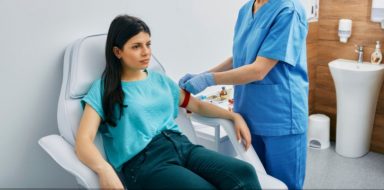Types of Rashes to Know About
Rashes are common among children and usually are not a major cause for concern. Skin rashes can have a variety of causes including bacterial, fungal and viral infection, or exposure to certain allergens. Correctly identifying the rash is key for effective treatment; however, different types of rashes can be difficult to tell apart.
The most common childhood rashes include ringworm, contact dermatitis, allergic eczema and hand, foot and mouth. Though usually harmless, these conditions can be uncomfortable, painful and itchy. Understanding the causes and triggers of each is vital for speedy and effective treatment, and for preventing future outbreaks.
Ringworm
Ringworm (tinea infection) is a common skin infection caused by a fungus (not worms). It gets its name from the ring-shaped appearance of the rash it causes, which has a red, wavy, worm-like border. It is especially common in children aged three to nine years old and can show up anywhere on the body including the scalp (tinea capitis), the groin (jock itch) and the feet (tinea pedis, or athlete’s foot).
What are the Symptoms of Ringworm?
The main symptom of ringworm is a red or silver rash that may be itchy, dry or swollen, and can appear anywhere on the body. It will usually have a distinctive wavy, red border. If ringworm is present on the scalp or feet, you may also notice an itchy, scaly scalp similar to that caused by dandruff. Ringworm may also lead to patches of hair loss. On the feet there could be red, scaly or cracked skin, often leading to itching, burning and a strong odor.
What Causes Ringworm?
Ringworm is caused by a type of fungus. It affects both humans and animals and is easily spread through:
- Direct contact with an infected person or animal
- Handling contaminated items (like clothing, towels, bedsheets and combs)
Less commonly, ringworm may also be spread through contact with infected soil. You can reduce your child’s risk of getting ringworm by:
- Encouraging regular handwashing, especially after touching soil or animals
- Examining any family pets for ringworm (and administering treatment, if necessary)
- Washing towels, clothes and bedsheets regularly
Treatment Options for Ringworm
If your child has ringworm, you will need to start treatment as soon as possible. Visit your local pharmacist for an anti-fungal cream and apply as directed (usually, this will be daily for a period of a few weeks). You should also discourage scratching during this time, as this can cause the rash to spread. In most cases, ringworm clears up within two weeks with anti-fungal treatment.
Contact Dermatitis
Contact dermatitis is an inflammatory skin condition that is usually triggered by contact with an irritant (such as soaps, detergents and perfumes). In some cases, flare-ups may be caused by certain allergens.
What are the Symptoms of Contact Dermatitis?
Contact dermatitis is characterized by skin irritation and inflammation. Specific reactions often vary between children, but the affected skin may be:
- Painful
- Itchy
- Red
- Swollen
- Dry, scaly, cracked or peeling
- Blistering or oozing
- Bleeding
Childhood seizures are actually common due to the development process of the brain. Here's what to do if your child experiences one.
What Causes Contact Dermatitis?
Contact dermatitis is caused by direct exposure to irritants and, less commonly, allergens. The most common irritants that cause contact dermatitis include:
- Soaps
- Detergents
- Fragranced lotions and perfumes
- Saliva
- Urine (if your child wears a diaper)
The allergens that most commonly cause contact dermatitis include:
- Metals (including nickel, chrome and mercury)
- Certain cosmetics
- Latex
- Some medicines (antibiotic, neomycin)
- Poison ivy, oak and sumac
Treatment Options for Contact Dermatitis
The best way to prevent contact dermatitis is to avoid the things that trigger it. If your child has contact dermatitis and you do not know what is causing it, consult a doctor for advice.
When dealing with a contact dermatitis flare-up, various creams and ointments (containing corticosteroids or antiseptic) may help to combat the symptoms. Moisturizer may also be recommended, to hydrate the skin. Consult a doctor for advice on the best treatment plan for your child.
Allergic Eczema
Eczema (atopic dermatitis) is a non-contagious, inflammatory skin condition that shows up before the age of five in most people. Eczema flare-ups can be triggered by many different things, including fragranced products, cold weather, dry climates and various allergies.
What are the Symptoms of Allergic Eczema?
Eczema is characterized by a red, itchy, scaly rash. This can be very irritating and the itching may disrupt sleep. Excessive scratching of this rash can break the skin, in which case the rash will ooze and crust over.
What Causes Allergic Eczema?
Doctors have established a clear link between eczema and allergies. 37% of children with moderate to severe asthma were also found to have food allergies and 80% of kids with the condition will develop pollen allergies and asthma in later childhood.
Allergic eczema may be triggered by exposure to specific allergens, including:
- Food (especially milk, eggs or peanuts)
- Pollen and other airborne allergens
Treatment Options for Allergic Eczema
If you think your child has allergic asthma, the first thing to do is identify the cause. Take your child to see a doctor, who can perform food allergy tests to determine if this is the problem. They may also recommend an exclusion diet, in which common trigger foods (such as wheat, eggs, milk, peanuts and soy) are cut out, one at a time, to establish which are causing the reaction.
Avoiding allergens and other triggers is the best way to keep childhood asthma under control. You can also use various ointments and moisturizers to minimize itching and keep skin hydrated.
Hand, Foot and Mouth
Hand, foot and mouth is a common viral infection most often seen in infants and children under the age of 10. Though highly contagious, hand, foot and mouth infections are usually not serious and often clears up by itself after seven to 10 days.
What are the Symptoms of Hand, Foot and Mouth?
Symptoms of hand, foot and mouth disease in children include:
- Painful blisters or sores inside the mouth or on the tongue
- A rash (which may turn into blisters) on the palms of the hands and the soles of the feet
- Spots or sores on the knees, elbows and buttocks
- Fever
- Sore throat
What Causes Hand, Foot and Mouth?
Hand, foot and mouth infections are caused by several strains of the coxsackievirus (usually, coxsackievirus A type 16) and enterovirus A71. It is usually spread by:
- Direct contact with an infected person
- Contact with contaminated objects (such as toys, doorknobs and other surfaces)
- Contact with the feces of a contaminated person
Treatment for Hand, Foot and Mouth
In most cases, hand, foot and mouth is cleared by the body’s immune system within 10 days and does not require treatment. If your child has hand, foot and mouth, you can help them through the recovery period in the following ways:
- Relieving pain and fever using over-the-counter pain medications, such as ibuprofen or acetaminophen (paracetamol)
- Giving children soft foods (such as mashed potato or applesauce)
- Giving children plenty of fluids to prevent dehydration. Ice lollies are a viable source of hydration and can also soothe a sore throat.
- If sores are present on the body, dress kids in loose clothing to prevent additional irritation
When Should You See a Doctor?
Though most childhood rashes are harmless, some can indicate a far more serious, underling infection (such as meningitis). You should take your child to see a doctor if:
- You do not know what is causing the rash
- Your child also has a fever or is generally unwell
- Your child’s rash is causing extreme distress, or is interrupting their everyday activities
- Your child has a weakened immune system
- Your child is very young (under six months old)
- Your child’s rash does not respond to recommended treatment
- Your child’s rash is infected (red, swollen, hot, oozing or painful)
- Has a rash that peels
- You are concerned about your child’s condition
In Conclusion
Rashes are common in babies, infants and young children. Though often uncomfortable, most rashes are not serious and clear up within a few weeks. Many rashes do not require specific treatment and symptoms can be eased by using over-the-counter medications and creams. Other rashes (such as ringworm) require medicated creams to treat.
Rarely, a rash may indicate a far more serious medical issue. If you are unsure about the cause of your child’s rash, their rash is accompanied by a fever or other symptoms, or you are concerned about your child’s condition, contact a doctor for a professional assessment.







